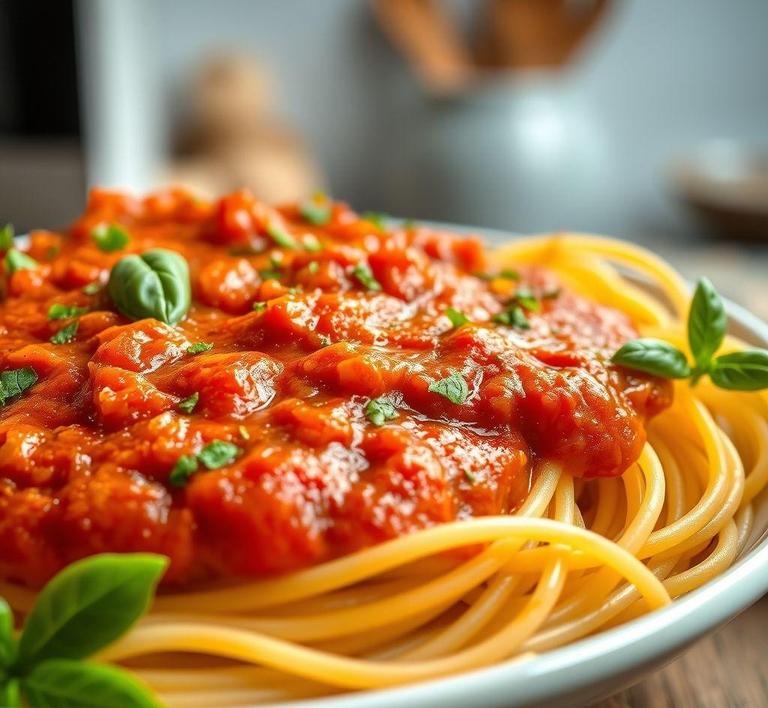When it comes to saving leftovers, the idea of refreezing meatless spaghetti sauce can be a game-changer for busy nights. Whether you’ve made a big batch or just have extra sauce after a cozy dinner, knowing how to properly refreeze it ensures you can enjoy your homemade sauce again without losing flavor or texture. While you might be wary about the idea of refreezing, don’t worry-it’s totally doable with the right method! In this guide, we’ll walk you through the best practices to keep your meatless spaghetti sauce fresh and tasty after freezing, so you can have that comforting spaghetti dinner whenever you need it!
Can You Refreeze Meatless Spaghetti Sauce?

When it comes to refreezing meatless spaghetti sauce, the answer isn’t as straightforward as a simple ‘yes’ or “no”. The possibility and safety depend on several factors, including how the sauce was handled after thawing and the presence of any contaminants.
Meatless spaghetti sauce, which is often tomato-based and enriched with herbs, garlic, onions, and possibly vegetables, generally has a lower risk of bacterial growth compared to meat-based sauces. Still, once a frozen sauce is thawed, bacteria can begin to multiply if the sauce is kept at unsafe temperatures for too long.
If you thawed your meatless spaghetti sauce in the refrigerator and it has been kept cold the entire time without being left out at room temperature for more than two hours, it is generally safe to refreeze it. The key here is that the sauce must not have sat out long enough to allow bacteria to grow to unsafe levels.
However, if the sauce was thawed on the counter or in warm water, or if it has been left unrefrigerated for more than a couple of hours, it’s best not to refreeze it. Doing so could increase the risk of foodborne illness. Refreezing in these cases won’t necessarily kill bacteria; it will simply preserve them, potentially causing health risks later.
Another important consideration is the texture and flavor of the sauce. Refreezing can impact the quality of your meatless spaghetti sauce, leading to changes in taste, texture, and appearance, especially if it contains delicate vegetables or herbs.
How To Refreeze Meatless Spaghetti Sauce?
If you determine that your meatless spaghetti sauce is safe to refreeze, the process should be done carefully to maintain both food safety and quality. Here’s a step-by-step guide:
-
Cool the Sauce Properly Before Freezing
If you have cooked the sauce freshly, allow it to cool completely at room temperature, but for no more than two hours. Then transfer it into the refrigerator to chill further before freezing. Never put hot sauce directly into the freezer, as this can raise the temperature inside your freezer and affect other foods.
-
Use Suitable Storage Containers
Transfer the sauce into airtight, freezer-safe containers or heavy-duty freezer bags. Make sure to leave some space at the top because the sauce will expand as it freezes.
-
Label and Date the Container
Always label your containers with the date of freezing. This helps you keep track of how long the sauce has been stored. Generally, spaghetti sauce can be safely stored in the freezer for up to 3-4 months for optimal taste and texture.
-
Freeze Quickly
Place the containers in the coldest part of the freezer to freeze the sauce quickly. Fast freezing helps preserve the sauce’s flavor and prevents the formation of large ice crystals that can affect texture.
-
Thaw Safely Next Time
When ready to use, thaw the sauce in the refrigerator overnight. Avoid thawing at room temperature or using hot water, as these methods increase bacterial risks.
-
Refreezing After Thawing
If you have thawed the sauce in the refrigerator and only reheated what you plan to eat immediately, you can refreeze the leftover sauce. But avoid refreezing sauce that has been left out or warmed and cooled multiple times.
Quality Impact
Repeated freezing and thawing can have a notable impact on the quality of meatless spaghetti sauce. Because the sauce typically contains water-rich ingredients such as tomatoes, onions, and sometimes vegetables, freezing causes the water inside to crystallize. When thawed, these ice crystals melt and can rupture the cellular structure of the vegetables, resulting in a sauce that may be thinner, more watery, or less vibrant in flavor.
Herbs and spices may also lose their potency over time. Fresh herbs, in particular, tend to dull in flavor and may develop a slightly muted or ‘stale’ taste after multiple freeze-thaw cycles.
Texture-wise, ingredients like onions or peppers can become softer or mushy. While this doesn’t make the sauce unsafe, it does affect the mouthfeel and overall enjoyment of your dish.
To minimize quality loss, consider freezing the sauce in smaller batches to avoid repeated refreezing. Alternatively, if you want to maintain maximum flavor and texture, try portioning out only what you expect to use per meal.
Yes, you can refreeze meatless spaghetti sauce safely-but only if it has been handled correctly. The sauce should have been thawed in the refrigerator and kept at safe temperatures without prolonged exposure to room temperature. Refreezing improperly handled sauce carries a risk of bacterial contamination and potential foodborne illness.
However, keep in mind that refreezing can compromise the texture, flavor, and overall quality of the sauce due to the breakdown of ingredients during the freeze-thaw process. To preserve the best taste and consistency, freeze your sauce in appropriately sized portions and avoid multiple freeze-thaw cycles.
By following proper storage and thawing methods, you can enjoy your delicious meatless spaghetti sauce safely and minimize waste without sacrificing too much on quality. Food safety first, but also keep your palate happy!
Is It Safe To Refreeze Meatless Spaghetti Sauce?
When it comes to refreezing meatless spaghetti sauce, the primary concern is food safety combined with preserving the quality of your sauce. The good news is that meatless spaghetti sauce – often made from tomatoes, herbs, vegetables, and sometimes dairy or oils – is generally safer to refreeze than meat-based sauces. This is because meatless sauces lack the high-risk proteins found in meats that tend to spoil more rapidly.
However, safety hinges on how the sauce has been handled post-thawing. The USDA recommends that food should only be refrozen if it has been thawed in the refrigerator and kept below 40°F (4°C). If your sauce has been left out at room temperature for more than two hours, bacteria can multiply to unsafe levels, making refreezing risky.
Refreezing meatless spaghetti sauce after proper refrigeration does not typically pose significant health risks, but it may alter the texture, flavor, and overall quality. The delicate balance of fresh tomato acids and herbs can sometimes suffer freezer burn or become watery upon thawing a second time.
In short: yes, it is generally safe if the sauce has been handled properly and kept cold, but expect some quality loss. If the sauce has been reheated, cooled, and then refrozen, the risk increases slightly, and the texture may degrade even more.
Signs That Meatless Spaghetti Sauce Should Not Be Refrozen
Knowing when to toss rather than refreeze is critical. Here are clear warning signs that your meatless spaghetti sauce should not be refrozen:
- Off or Sour Smell: A distinct sour or rancid odor indicates spoilage. The natural acidity of tomato sauce can mask mild spoilage odors, so trust your nose carefully.
- Mold Growth: Any visible mold-white, green, black, or fuzzy-means your sauce should be discarded immediately. Freezing doesn’t kill mold spores; it only slows their growth.
- Change in Texture: If your sauce appears slimy or has separated excessively, this could indicate bacterial activity or spoilage.
- Unusual Color: A dull or darkened sauce, or strange discoloration (such as browning or fading), often means the sauce has deteriorated.
- Left Out Too Long: If the sauce was left out at room temperature for more than two hours (or one hour if above 90°F), it’s safer to throw it away rather than risk refreezing.
- Signs of Fermentation: Bubbling or fizzing indicates unwanted fermentation has started, a clear sign the sauce is unsafe.
Recognizing these signs helps prevent foodborne illnesses and ensures you don’t compromise on taste and nutrition.
Common Refreezing Mistakes
Even with the best intentions, many people make mistakes when refreezing meatless spaghetti sauce, leading to waste or health risks. Here are some frequent pitfalls to avoid:
- Refreezing Sauce Thawed at Room Temperature: Thawing on the counter or in warm water can cause unsafe bacteria growth. Refreezing after this is dangerous.
- Not Cooling Before Freezing: Putting hot or warm sauce directly into the freezer raises the freezer’s internal temperature and promotes ice crystal formation, which damages texture and flavor.
- Using Improper Containers: Storing sauce in containers that aren’t airtight or freezer-safe can cause freezer burn and contamination.
- Refreezing Multiple Times: Each freeze-thaw cycle breaks down the sauce’s quality and texture, leading to a watery, bland end product.
- Ignoring Portion Control: Freezing large quantities makes it harder to thaw only what you need, increasing the temptation to refreeze leftovers.
By being mindful of these errors, you’ll maintain your sauce’s safety and taste much better.
Tips And Tricks
To make the most of refreezing meatless spaghetti sauce safely and deliciously, keep these handy tips in mind:
- Portion Before Freezing: Freeze sauce in small, meal-sized portions. This allows you to thaw only what you need without excess leftovers.
- Use Proper Containers: Opt for airtight, freezer-safe containers or heavy-duty freezer bags. Remove as much air as possible to reduce freezer burn.
- Cool Before Freezing: Let the sauce cool completely before freezing. Spread it in shallow containers to speed up cooling.
- Label and Date: Always mark containers with the date you froze them, so you can use the oldest first. Generally, meatless spaghetti sauce keeps well for 3 to 4 months in the freezer.
- Thaw Safely: Thaw in the refrigerator overnight or use a microwave’s defrost setting. Avoid leaving sauce out at room temperature.
- Reheat Properly: When reheating, bring the sauce to a simmer to kill any lingering bacteria and restore flavor.
- Add Fresh Herbs Later: If you want a fresh flavor boost after thawing, add fresh basil, oregano, or parsley right before serving.
Conclusion
Refreezing meatless spaghetti sauce can be a convenient and safe way to reduce food waste and enjoy your homemade or store-bought sauce later. The key lies in how you handle the sauce after thawing – maintaining safe temperatures and avoiding repeated freeze-thaw cycles preserves both food safety and quality.
Watch out for telltale signs of spoilage like off smells, mold, or unusual textures, and steer clear of common mistakes like refreezing sauce thawed at room temperature or using unsuitable containers. By portioning your sauce thoughtfully and storing it properly, you can keep your meals flavorful and nutritious for months.
Ultimately, refreezing meatless spaghetti sauce, done with care, is a practical solution that can save you time and money without compromising your health or the enjoyment of your meals.


